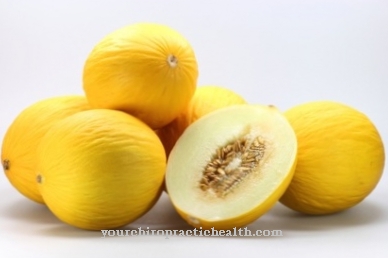Drying is the oldest known method of natural preservation so that perishable food can be kept in stock over a long period of time. So were Prunes already known in antiquity. They were valued as remedies and were popular as a valuable addition to the daily diet. Even today they are a valuable food for a conscious and balanced diet.
Prunes strengthen the immune system and help reduce stress when moods and depression disrupt the daily routine.
What you should know about prunes

Dried plums are available all year round - the season is only for fresh plums and in European regions this is from July to October, in Chile and Argentina the harvest begins in March. Several years pass before a plum tree bears the first fruit. When it has grown to a height of around 5 meters, it can bear up to 150 kilograms of fruit.
For harvest, the branches are shaken so that only the ripe fruits really fall off. Since they are sensitive and should not be injured, they are caught in nets and then immediately transported for further processing. With the help of hot air through special drying systems, moisture is removed from the plums and the drying process begins. Or natural drying in the shade or in the sun is used. Three kilograms of fresh plums are required for one kilo of prunes. Then vibrating plates with different sized punchings are used to sort the plums according to size, after which the fruits are pitted, for which various methods are used.
The origin of the plums cannot be clearly proven, it is assumed that their origin is in Persia and that they were brought to Greece by Alexander the Great, because Damascus was then a well-known center for the plum trade. In Egypt plums were found in graves so that there would be supplies for the further journey. Not only for the journey to the afterlife, but also for the caravan routes through the desert, prunes were always there as a nutrient-rich source of energy.
The doctors in ancient Greece also praised its laxative effect, even the Roman poet Marcus Valerius Martial praised: "Take plums for the rotten burden of old age, because they tend to loosen the tense stomach." It is believed that Charlemagne brought them to Germany, where today the greatest harvests come from Baden-Württemberg and Rhineland-Palatinate. Today plums are mainly grown in the Balkans, the Mediterranean region - Spain, Italy, France - in Germany, South Africa and Chile. The taste of a prune can be described as sweet and tart, whereby the sweet predominates as with all dried fruits.
Probably the tastiest and best-known prune comes from the southwest of France. It is the "Pruneau d`Agen PGI" that grows around the town of Agen and has the best growing conditions there to develop its fine, soft texture and full-bodied taste.
Importance to health
Prunes are not only delicious, they are also very healthy. In addition to many other ingredients, they contain the indigestible plant fibers pectin and cellulose. These swell up in the intestine, stimulate digestion, and contribute to cancer prophylaxis because they take toxins and waste with them on their way through the intestine.
Their high fiber content helps lower or keep cholesterol levels constant. As part of a balanced and healthy diet, fiber is essential. Prunes are one of the sweetest sources of fiber. Its many other important ingredients protect the body against metabolic, liver and gallbladder diseases, but also have a preventive effect against hardening of the arteries, gout and rheumatism. For those who suffer from heartburn, prunes offer fantastic healing properties. Their anthocyanins, bioactive plant substances, also have a positive effect on blood pressure and protect the heart and blood vessels.
So there is a lot of healthy content in these wrinkled dried fruits. This comes about because water is removed from the fruit by drying and its contents are then available in a more concentrated form. More than 100-150 grams of prunes per day should not be consumed as this has been shown to lead to intestinal problems such as flatulence and diarrhea. As a snack on the way, prunes are ideal for hikers and athletes, because they have a balanced proportion of the fruit's own sugar, which provides quick and healthy energy.
Ingredients & nutritional values
| Nutritional information | Amount per 100 gram |
| Calories 240 | Fat content 0.4 g |
| cholesterol 0 mg | sodium 2 mg |
| potassium 732 mg | protein 2.2 g |
| carbohydrates 64 g | Fiber 7 mg |
Prunes are power fruits with a very intense taste and valuable ingredients. A prune absorbs 4 mg of magnesium and 5 mg of calcium, which is one tenth of the daily requirement for magnesium and one fifth of the daily requirement for calcium - a pretty impressive result for such a small fruit.
The secondary plant substances are also a very important ingredient, the many antioxidants have a very positive effect on health. Prunes are also a very good supplier of vitamins, they contain a lot of vitamins C, E, K, provitamin A and many vitamins from group B, which are important for an intact nervous system and a healthy metabolism. They have potassium, iron, calcium, zinc, phosphorus and magnesium in their supply of minerals.
Intolerances & allergies
Anyone suffering from fructose intolerance should consume prunes with caution, as it could lead to nausea, stomach pain or diarrhea. While prunes are a very healthy food, they can sometimes be sulphurized, which can cause nausea and headaches in sensitive people. So caution and precise information is required. Natural dried fruits from organic production are best for your health.
Shopping & kitchen tips
Prunes can be stored very well because they do not lose any of their valuable ingredients even over a longer period of time. Sealed airtight in bags or cans, they will stay fresh for a long time in the vegetable compartment of the freezer. If properly stored in an optimal environment - dry and dark, they can be stored unopened for up to a year.
Preparation tips
Prunes often turn out to be an indispensable ingredient for tasty dishes. Meat-fruit combinations were already part of the almost daily diet in ancient Persia and of course still predominantly in all oriental countries.
North African tagine dishes, the dried fruit not only gives it a deep sweetness, it also wonderfully absorbs the aromas of the meat. In salads, in soups or as a filling for roast goose or pork, prunes are a wonderfully fruity flavor for us. Also as a snack between meals, in yoghurt or muesli or together with cream cheese, as a dessert or in a fruit cake, prunes are always an excellent addition. For an oriental lamb stew, prunes are an essential ingredient and for an exotic leg of lamb, the prunes must be cooked in the baking dish.
Beef roulades taste wonderfully sweet with a sauce made from prunes.












.jpg)

.jpg)
.jpg)











.jpg)